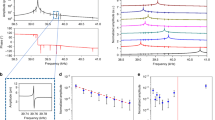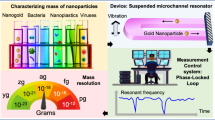Abstract
Mechanical resonators are widely used as inertial balances to detect small quantities of adsorbed mass through shifts in oscillation frequency1. Advances in lithography and materials synthesis have enabled the fabrication of nanoscale mechanical resonators2,3,4,5,6, which have been operated as precision force7, position8,9 and mass sensors10,11,12,13,14,15. Here we demonstrate a room-temperature, carbon-nanotube-based nanomechanical resonator with atomic mass resolution. This device is essentially a mass spectrometer with a mass sensitivity of 1.3 × 10−25 kg Hz−1/2 or, equivalently, 0.40 gold atoms Hz−1/2. Using this extreme mass sensitivity, we observe atomic mass shot noise, which is analogous to the electronic shot noise16,17 measured in many semiconductor experiments. Unlike traditional mass spectrometers, nanomechanical mass spectrometers do not require the potentially destructive ionization of the test sample, are more sensitive to large molecules, and could eventually be incorporated on a chip.
This is a preview of subscription content, access via your institution
Access options
Subscribe to this journal
Receive 12 print issues and online access
$259.00 per year
only $21.58 per issue
Buy this article
- Purchase on Springer Link
- Instant access to full article PDF
Prices may be subject to local taxes which are calculated during checkout



Similar content being viewed by others
References
Sauerbrey, G. Verwendung von schwingquarzen zur wagung dunner schichten und zur mikrowagung. Zeitschrift Fur Physik 155, 206–222 (1959).
Cleland, A. N. & Roukes, M. L. Fabrication of high frequency nanometer scale mechanical resonators from bulk Si crystals. Appl. Phys. Lett. 69, 2653–2655 (1996).
Poncharal, P., Wang, Z. L., Ugarte, D. & de Heer, W. A. Electrostatic deflections and electromechanical resonances of carbon nanotubes. Science 283, 1513–1516 (1999).
Craighead, H. G. Nanoelectromechanical systems. Science 290, 1532–1535 (2000).
Sazonova, V. et al. A tuneable carbon nanotube electromechanical oscillator. Nature 431, 284–287 (2004).
Ekinci, K. L. & Roukes, M. L. Nanoelectromechanical systems. Rev. Sci. Instrum. 76, 061101 (2005).
Mamin, H. J. & Rugar, D. Sub-attonewton force detection at millikelvin temperatures. Appl. Phys. Lett. 79, 3358–3360 (2001).
LaHaye, M. D., Buu, O., Camarota, B. & Schwab, K. C. Approaching the quantum limit of a nanomechanical resonator. Science 304, 74–77 (2004).
Knobel, R. G. & Cleland, A. N. Nanometre-scale displacement sensing using a single electron transistor. Nature 424, 291–293 (2003).
Ekinci, K. L., Huang, X. M. H. & Roukes, M. L. Ultrasensitive nanoelectromechanical mass detection. Appl. Phys. Lett. 84, 4469–4471 (2004).
Ekinci, K. L., Yang, Y. T. & Roukes, M. L. Ultimate limits to inertial mass sensing based upon nanoelectromechanical systems. J. Appl. Phys. 95, 2682–2689 (2004).
Ilic, B. et al. Attogram detection using nanoelectromechanical oscillators. J. Appl. Phys. 95, 3694–3703 (2004).
Yang, Y. T., Callegari, C., Feng, X. L., Ekinci, K. L. & Roukes, M. L. Zeptogram-scale nanomechanical mass sensing. Nano Lett. 6, 583–586 (2006).
Peng, H. B., Chang, C. W., Aloni, S., Yuzvinsky, T. D. & Zettl, A. Ultrahigh frequency nanotube resonators. Phys. Rev. Lett. 97, 087203 (2006).
Feng, X. L., He, R. R., Yang, P. D. & Roukes, M. L. Very high frequency silicon nanowire electromechanical resonators. Nano Lett. 7, 1953–1959 (2007).
Schottky, W. Regarding spontaneous current fluctuation in different electricity conductors. Annalen Der Physik 57, 541–567 (1918).
Hartmann, C. A. U¨ber die bestimmung des elektrischen elementarquantums aus dem schroteffekt. Ann. Phys. (Leipz.) 65, 51–78 (1921).
Treacy, M. M. J., Ebbesen, T. W. & Gibson, J. M. Exceptionally high Young's modulus observed for individual carbon nanotubes. Nature 381, 678–680 (1996).
Cleland, A. N. Foundations of Nanomechanics (Springer-Verlag, New York, 2003).
Hutchison, J. L. et al. Double-walled carbon nanotubes fabricated by a hydrogen arc discharge method. Carbon 39, 761–770 (2001).
Jensen, K., Weldon, J., Garcia, H. & Zettl, A. Nanotube radio. Nano Lett. 7, 3508–3511 (2007).
de Heer, W. A., Chatelain, A. & Ugarte, D. A carbon nanotube field-emission electron source. Science 270, 1179–1180 (1995).
Purcell, S. T., Vincent, P., Journet, C. & Binh, V. T. Tuning of nanotube mechanical resonances by electric field pulling. Phys. Rev. Lett. 89, 276103 (2002).
van der Ziel, A. Noise. (ed., Everitt, W. L.) (Prentice-Hall, New York, 1954).
Langmuir, I. Chemical reactions at low pressures. J. Am. Chem. Soc. 37, 1139–1167 (1915).
Arthur, J. R. & Cho, A. Y. Adsorption and desorption kinetics of Cu and Au on (0001) graphite. Surf. Sci. 36, 641–660 (1973).
Newland, D. E. An Introduction to Random Vibrations and Spectral Analysis (Longman, New York, 1984).
Regan, B. C., Aloni, S., Ritchie, R. O., Dahmen, U. & Zettl, A. Carbon nanotubes as nanoscale mass conveyors. Nature 428, 924–927 (2004).
Karas, M., Bachmann, D., Bahr, U. & Hillenkamp, F. Matrix-assisted ultraviolet-laser desorption of nonvolatile compounds. Int. J. Mass Spectrom. Ion Processes 78, 53–68 (1987).
Fenn, J., Mann, M., Meng, C., Wong, S. & Whitehouse, C. Electrospray ionization for mass spectrometry of large biomolecules. Science 246, 64–71 (1989).
Acknowledgements
We thank B. Aleman for technical assistance. This work was supported by the Director, Office of Energy Research, Office of Basic Energy Sciences, Materials Sciences and Engineering Division, of the US Department of Energy under contract DE-AC02-05CH11231, which provided nanotube synthesis, detailed TEM characterization and UHV testing of the nanomechanical mass spectrometer. It was also supported by the National Science Foundation within the Centre of Integrated Nanomechanical Systems, under grant EEC-0425914, which provided for design and assembly of the spectrometer. K.K acknowledges support from a Samsung Graduate Fellowship.
Author information
Authors and Affiliations
Contributions
K.J. and A.Z. conceived the experiments and co-wrote the paper. K.J. designed and constructed the experimental apparatus, prepared nanotube samples, recorded the data and analysed the results. K.K. helped with apparatus construction and sample preparation
Corresponding author
Supplementary information
Rights and permissions
About this article
Cite this article
Jensen, K., Kim, K. & Zettl, A. An atomic-resolution nanomechanical mass sensor. Nature Nanotech 3, 533–537 (2008). https://doi.org/10.1038/nnano.2008.200
Received:
Accepted:
Published:
Issue Date:
DOI: https://doi.org/10.1038/nnano.2008.200
This article is cited by
-
A review of gas sensors based on carbon nanomaterial
Carbon Letters (2022)
-
Molecular-resolution micro-resonant biosensor with adjustable natural frequency
Journal of Mechanical Science and Technology (2022)
-
Modes of Vibration of Single- and Double-Walled CNTs with an Attached Mass by a Non-local Shell Model
Journal of Vibration Engineering & Technologies (2022)
-
Reaching silicon-based NEMS performances with 3D printed nanomechanical resonators
Nature Communications (2021)
-
Investigation of dynamic pull-in instability of suspended microchannel resonators using homotopy analysis method
Journal of the Brazilian Society of Mechanical Sciences and Engineering (2021)



